Read Reviews
The Best Garden Wheelbarrows
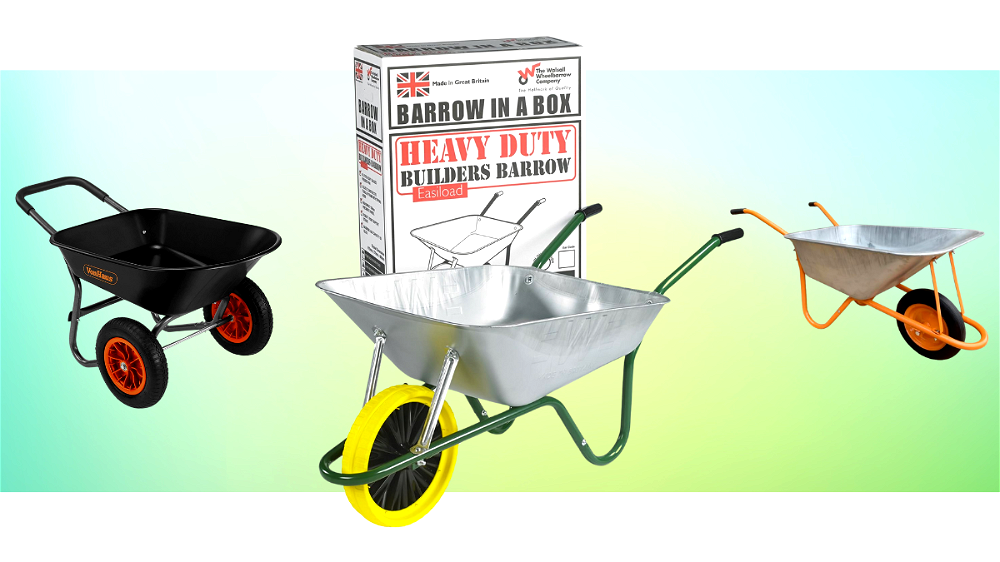
-
Best garden wheelbarrow overall - VonHaus Heavy Duty Two Wheeled Wheelbarrow
-
Best for small/medium gardens - Walsall Galvanized Wheelbarrow in a Box
-
Best lightweight wheelbarrow - Draper Garden Wheelbarrow
-
Best tyres - DJM Heavy Duty Garden Wheelbarrow
-
Best heavy duty wheelbarrow - Kidsnado W Puncture-Proof Wheels Wheelbarrow
Garden Wheelbarrow Reviews
1. VonHaus Heavy Duty Two Wheeled Wheelbarrow
Best garden wheelbarrow overall
- The U-shaped handle means the wheelbarrow can be moved with one hand and pushed or pulled.
- Lightweight design and U-shaped handle means it can be stored hanging up.
- Extremely stable and well balanced - perfect for gardeners who find it harder to balance a 3-wheeled wheelbarrow.
- Plastic tray is robust and durable enough for jobs around the garden.
- The tyres have very thick tread and are hardwearing.
- Two wide tyres result in a 70 cm wheel base which may be too big for some smaller gardens and pathways.
- There is no supportive tipping bar at the front, meaning the plastic tray can bend when tipping out heavier loads.
- Pneumatic tyres are inflatable and not puncture proof; however, they are thick and can be swapped out in the future.
- The instructions indicate that the bolts should be fixed sticking up into tray; many customers resolve this by reversing them.
- During assembly, some of the pieces may need to be worked into place with some force.
- Capacity
- 78L
- Weight
- 12kg
- Material
- Plastic
- No. of Wheels
- 2
- Design
- 4.7
- Durability
- 4.4
- Manoeuvrability
- 4.6
- Value for Money
- 4.4
The VonHaus Heavy Duty Two Wheeled Wheelbarrow makes it a breeze to navigate through the garden; its two-wheel design makes it much more stable than traditional single-wheel models, and it can even be pushed and pulled with one hand.
Designed for smaller DIY and gardening jobs, this wheelbarrow has a 78 L capacity which makes it easy to manoeuvre. It’s been built for everyday use, perfect for moving around soil, gardening tools, and other medium loads.
With a U-shaped handle and robust, yet lightweight, plastic tray, the VonHaus wheelbarrow is a great choice for gardeners who need something that is well balanced and not too heavy. It can be controlled easily and moved in several different ways.
Whilst the wide wheel base does mean this wheelbarrow may struggle in narrower passages (it is 70 cm wide in total), the pneumatic tyres are robust and able to cope with the majority of garden terrain.
This VonHaus model is one of the best wheelbarrows for anyone looking for something more stable than a 3-point traditional wheelbarrow. With its strong powder coated steel frame, and stable wheel base, it will stand up to the pressures of everyday gardening tasks.
Wheelbarrows like this one, with plastic trays, are perfect for most gardeners; however, if you need to complete heavier jobs you might be better off with a wheelbarrow with a metal tray.
Did you find this review helpful?
2. Walsall Galvanized Wheelbarrow in a Box[ SAVE 4% ]
Best for small/medium gardens
- Puncture-proof wheel is solid and can't burst.
- Good wheelbarrow for light/mid-weight gardening work.
- Arrives in a small, convenient box.
- Manufactured in the UK, supporting British businesses.
- Galvanized steel tray is well protected against weathering.
- Not as sturdy as a ready-assembled wheelbarrow.
- Assembly can be a little difficult and require a bit of force.
- May not stand up to consistently carrying heavy loads like bags of concrete.
- Some found that the tyre did not stand up to difficult, hard terrain.
- The supports may require some bending into shape during assembly.
- Capacity
- 85L
- Weight
- 10.92kg
- Material
- Steel
- No. of Wheels
- 1
- Design
- 4.5
- Durability
- 4.1
- Manoeuvrability
- 4.4
- Value for Money
- 4.6
A ‘barrow in a box’ is Walsall’s ingenious idea to make ordering a wheelbarrow to your home even simpler – who knew we’d been missing something so inventive all this time?
Assembling the Walsall 85 Ltr Galvanized Wheelbarrow is relatively straight forward, with clearly detailed instructions. That said, there are times when pieces need a bit of coaxing into place, and it’s good advice not to tighten any of the nuts until they are all in position. Once assembled, this smart, galvanised steel wheelbarrow will be ready for the garden.
The puncture-proof wheel means you won’t have to be digging around for a puncture repair kit after using this wheelbarrow on rough terrain. Instead, the solid wheel keeps its shape well. However, this wheelbarrow is still best suited to gardening work and the odd heavy duty task. Using it on very jagged terrain may damage the wheel’s casing. Still, you won’t find the tyre punctured by thorns, and it doesn’t dig in to damp grass or soil either.
The tray itself is also pretty strong, giving plenty of scope to fill it to its 85 L capacity. It may not quite match up to the strength of a ready-assembled wheelbarrow, but for the convenience and price, Walsall have definitely created an excellent wheelbarrow for small/medium gardens.
Did you find this review helpful?
3. Draper Garden Wheelbarrow[ SAVE 7% ]
Best lightweight wheelbarrow
- Lightweight design makes this a great wheelbarrow for gardeners who struggle with heavy lifting.
- 65 L is a good size for the majority of gardening tasks without being too heavy.
- Well suited to smaller gardens; small enough to be easy to store and only 62 cm wide.
- Robust metal tray that will easily move soil, sand, shingle etc.
- Customers generally feel that the quality-to-value ratio is good.
- Needs to be assembled at home which is a surprise to some customers.
- The assembly instructions are not very clear and can be a bit difficult to work out.
- Assembly requires tools which are not included: a couple of different spanner sizes and a pump to inflate the wheel.
- The holes may not line up well during assembly and may require some force to get them in place.
- The metal construction is not suitable for heavy-duty tasks such as building work.
- Capacity
- 65L
- Weight
- 7.4kg
- Material
- Steel
- No. of Wheels
- 1
- Design
- 4.5
- Durability
- 4.6
- Manoeuvrability
- 4.7
- Value for Money
- 4.6
For those who are looking for a light, metal wheelbarrow, the Draper DRA31619 Garden Wheelbarrow is an excellent contender. Bringing the sturdy qualities of galvanised steel, combined with a manageable 7.4 kg construction, in this wheelbarrow Draper have created a product that is both hardwearing and practical.
With a 65 L capacity, this wheelbarrow is suitable for most gardening jobs without being so loaded that it becomes unwieldy. If you have narrow pathways or tight corners to negotiate, the 62 cm width and one-wheeled design will help transport material without causing issues with manoeuvrability.
Galvanised throughout and manufactured with a rigid tubular frame, this wheelbarrow is well made. It’s smaller than the other wheelbarrows featured here, making it easier to store and ideal for smaller gardens.
Whilst made of metal, this still doesn’t substitute for a builder’s wheelbarrow; it’s one of the best wheelbarrows for gardening tasks if you want pneumatic tyres, but it’s not been designed for heavy-duty lifting or building work.
It’s particularly suitable for gardeners who find heavy lifting difficult as the light frame of this Draper’s wheelbarrow means you’re not left carting around excess weight unnecessarily.
Plus, it’s a very affordable wheelbarrow – so it’s easier on the wallet too.
Did you find this review helpful?
4. DJM Heavy Duty Garden Wheelbarrow
Best tyres
- Sturdy enough to carry some heavier loads in the garden.
- Tyre can be pumped up easily.
- Deep tray is practical for garden jobs.
- Large capacity limits journey numbers.
- Good manoeuvrability around the garden.
- May feel top heavy or unbalanced when filled with a heavy load.
- Assembly can be fiddly as the holes are difficult to align.
- Tray isn't galvanised and should therefore be covered when left outside.
- Some have found the handles to be a bit too short.
- Capacity
- 90L
- Weight
- 12.44kg
- Material
- Steel
- No. of Wheels
- 1
- Design
- 4.4
- Durability
- 4.7
- Manoeuvrability
- 4.7
- Value for Money
- 4.4
If your gardening work consists of moving heavier loads, perhaps shifting gravel or bricks every now and again, this DJM Steel Garden Wheelbarrow will rise to the challenge. It’s a great all-rounder that handles reasonably heavy-duty garden jobs.
The deep tray makes it easy to keep loading in material, making full use of the 90 L capacity whilst keeping things well balanced. It’s still not a heavyweight builder’s wheelbarrow, but when used with common sense it can handle pretty large loads.
When carting material around the garden, there’s nothing worse than battling against a sticking wheel or tricky manoeuvrability; so, the 14″ pneumatic tyre on this DJM wheelbarrow is a breath of fresh air. It’s sturdy and can manage a variety of tough terrains without letting you down.
It comes unassembled and can be a little tricky to put together, requiring a bit of oomph here and there to persuade the pieces into place.
Also, one final thing to note is that the handles are a little shorter than some other wheelbarrows, this can affect how easy it is to tip out heavier weights because it alters the centre of balance.
Overall though, it comes out as the best garden wheelbarrow thanks to its large capacity, robust construction and sturdy tyres.
Did you find this review helpful?
5. Kidsnado W Puncture-Proof Wheels Wheelbarrow
Best heavy duty wheelbarrow
- Comes ready assembled - there's no tricky assembly required and it can be used straight away.
- The inclusion of two front wheels makes this wheelbarrow well balanced even when full.
- A massive time saver - jobs that used to take several trips can often be done in one go!
- The puncture proof wheels are robust and never require inflating.
- The plastic tray is strong and stands up to the challenge of carrying larger loads.
- When full, the wheelbarrow can be extremely heavy - you need to be careful not to overfill it with heavy material.
- At 90 cm wide this wheelbarrow may be difficult to manoeuvre around smaller spaces, through gates, etc.
- The tyres can be a bit unforgiving over bumpy ground; this wheelbarrow is best suited to use on relatively level terrain.
- The two-wheel design does reduce manoeuvrability compared to one wheel - it may take a bit of getting used to.
- Some customers found that the tipping bar made it hard to fully invert the wheelbarrow and empty it completely.
- Capacity
- 200L
- Weight
- 20kg
- Material
- Plastic
- No. of Wheels
- 2
- Design
- 4.5
- Durability
- 4.5
- Manoeuvrability
- 4.2
- Value for Money
- 3.9
There are some jobs where even a standard, large 95 L wheelbarrow just won’t do. If you’re looking for something bigger still, it might just be time to bring out the cavalry.
Introducing: the Kidsnado W Puncture-Proof Wheels Wheelbarrow; a 200 L wheelbarrow that will dramatically reduce the number of trips you need to make in the garden. And that’s no exaggeration!
Whether moving compost and soil in the garden, or mucking out at the stables, this large plastic wheelbarrow really reduces time spent on tasks. With two puncture-proof tyres to evenly spread the weight, and a well-constructed supportive metal frame, Kidsnado’s wheelbarrow easily shifts large volumes of material in a single trip.
Best suited to moving light to mid weight items, the large capacity does mean that this wheelbarrow can get very heavy depending on what you fill it with. However, for general garden maintenance, it’s ones of the best wheelbarrows available.
Measuring 90 cm wide, this wheelbarrow works best when used in open spaces and wider areas – you may find it challenging to navigate along smaller pathways and around a narrow garden.
All that’s left to decide now is what to do with all the time you’ve saved from using this impressive wheelbarrow – jobs that used to take four trips now might well only take one!
Did you find this review helpful?
Compare Product Features
Use the dropdown to sort the table by the feature you want to see.
VonHaus Heavy Duty Two Wheeled Wheelbarrow
- 4.5
- 78L
- 12kg
- Plastic
- 2
Walsall Galvanized Wheelbarrow in a Box
- 4.4
- 85L
- 10.92kg
- Steel
- 1
Draper Garden Wheelbarrow
- 4.6
- 65L
- 7.4kg
- Steel
- 1
DJM Heavy Duty Garden Wheelbarrow
- 4.6
- 90L
- 12.44kg
- Steel
- 1
Kidsnado W Puncture-Proof Wheels Wheelbarrow
- 4.3
- 200L
- 20kg
- Plastic
- 2
How to Choose The Best Garden Wheelbarrow
Ah, the common wheelbarrow – such an incredibly useful garden staple to speed up jobs and spare the ol’ back from arduous heavy lifting!
It’s undeniably a vital piece of garden equipment, but there are a surprising number of different wheelbarrow designs out there to choose from – some well-suited to garden pottering, and others better equipped for commercial use.
When trying to find the best wheelbarrow for your specific needs, it can be hard to know what to look out for and what to avoid; take a look at the following tips to help you make an informed purchase.
READ NEXT: The Best Garden Trolleys
Choosing a Suitable Capacity
The best wheelbarrows are available in a range of sizes, with capacities to suit almost any task.
Smaller wheelbarrows are obviously less practical when it comes to transporting garden waste, but they more than make up for this with good manoeuvrability and ease of storage. You may need to consider what is more important to you: being able to complete a job in the least trips possible, or being able pack away or transport your wheelbarrow with ease.
Maximum weight load is also something to look out for. Smaller steel wheelbarrows will likely be able to carry more weight than a large-yet-flimsy plastic one! Sometimes it’s better to buy a smaller wheelbarrow of better quality, than buy something bigger for the same price and find that it breaks after a short time.
A large wheelbarrow will of course allow you transport more garden waste; however, you should consider both its maximum weight capacity and your own strength. Large wheelbarrows, filled to capacity, can be unwieldy and extremely heavy. If you can manage this, then great! But it’s something to think about before purchasing – you may not be able to use a bigger wheelbarrow to its full capacity anyway!
For most gardening tasks, a capacity of between 80 to 120 L is should be adequate for most circumstances.
READ NEXT: The Best Cement Mixers
Selecting the Correct Wheel Type
The wheels on the wheelbarrow are another important thing to consider.
In general, you want to look for sturdy wheels that are able to easily take the weight of heavy loads.
If you’re working on very uneven terrain, for example doing building work, you might want to choose a wheel with a wider width so that it can spread the load better and a pneumatic tyre that won’t puncture.
Pneumatic wheels makes it easier to move loads over uneven surfaces, so these are well-suited to use on difficult ground. However, they can go flat and need to be re-inflated, or puncture. Which is just something to be aware of.
For infrequent wheelbarrow use, you’ll likely find a solid tire is more practical; these don’t deflate over time like a pneumatic wheel and can be left in the shed or garage for years, ready for use at the drop of a hat.
When buying a wheelbarrow, you’ll also have a choice of either one or two wheels. This won’t make much difference to the load capacity, but it’s still worth considering. One wheel will make the wheelbarrow a lot easier to turn and navigate, but it’s more likely to tip over if overloaded than a two-wheel model
Wheelbarrows with two wheels are sturdy, but due to the wider wheel base, and inability to pivot, they can be difficult to manoeuvre.
READ NEXT: The Best Garden Shredders
The Best Material for Your Wheelbarrow
Wheelbarrows are usually made from either plastic or galvanised steel.
Steel is far stronger than plastic, meaning even smaller steel wheelbarrows will likely have a larger weight capacity than bigger plastic models.
However, plastic wheelbarrows can still be very strong and durable provided they have a strong steel frame for support. They also won’t rust, dent or distort like some metal models.
Galvanised steel wheelbarrows with solid steel skids are heavier, so this is also worth keeping in mind – you’ll likely already be shifting heavy loads so may not want to add the weight of a dense wheelbarrow on top of that!
While more durable, galvanised steel wheelbarrows might be more prone to rust if not properly maintained.
Garden Wheelbarrow FAQs
A solid wheel is usually made with a metal rim and a PVC tyre. This means it cannot be punctured. This type of wheel is an ideal option if you are using the wheelbarrow in a place where there may be sharp or rough objects that would puncture a pneumatic tyre. If you are only using the wheelbarrow occasionally, on relatively flat ground, this makes a good choice.
A pneumatic tyre has a rubber inner tube that is inflated and protected by a rubber tyre. This makes it nice and bouncy so it is easier to use over uneven ground; this ‘suspension’ means it absorbs many of the jolts and bumps making it more comfortable to use. The disadvantage of these tyres is that they can go flat over time or be punctured by sharp objects.
That said, a pneumatic tyre is fairly easy to repair, and repair kits or replacement inner tubes are readily available.
If the tyre on your wheelbarrow goes flat after not being used for a while you can simply pump it up with a bicycle pump.
However, if the tyre quickly goes down again this indicates a puncture. This is relatively simple to fix and all you will need is a puncture repair kit which you can buy from cycling shops. Follow these steps to fix a punctured tyre:
- Remove the wheel. Take off the tyre and remove the inner tube.
- Soak the inner tube in water: look for tiny air bubbles that indicate where the hole in the tube is.
- Identify the location of the hole and remember where it is.
- Dry the tube
- Fix the hole with a puncture repair kit. This is simply a matter of gluing a rubber patch over the hole with the glue and patches supplied in the repair kit.
- Reassemble the wheel, put it back on the barrow, and you’re done!
This depends on the material and quality of the wheelbarrow. If you do leave it outside, you should lean the wheelbarrow against a wall or fence. This will allow for drainage, stopping the tray from filling with water and corroding.
To keep your wheelbarrow in the best condition, I recommend wiping it down with a cloth after ever use. Sandpaper can be used to keep the handles in good condition, and the wheel should be oiled if it starts squeaking. Ensure your wheelbarrow is dry and stored in a sheltered area (or leant against a wall) to prevent rust.
Start typing and press enter to search

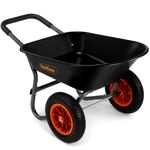
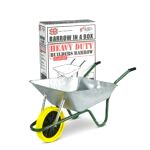
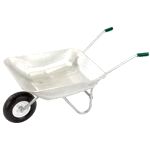
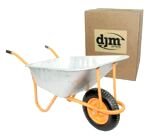
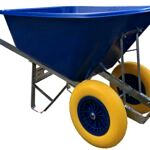
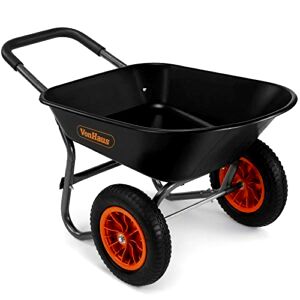
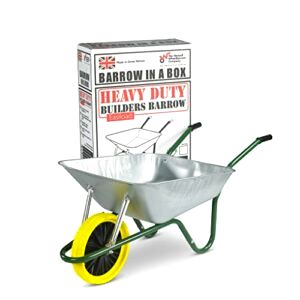
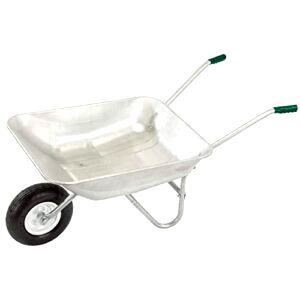
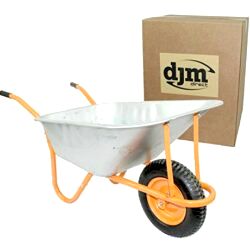
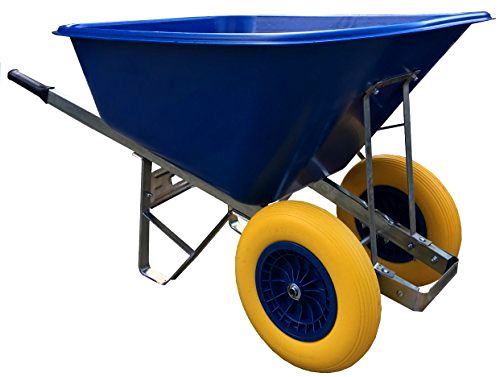
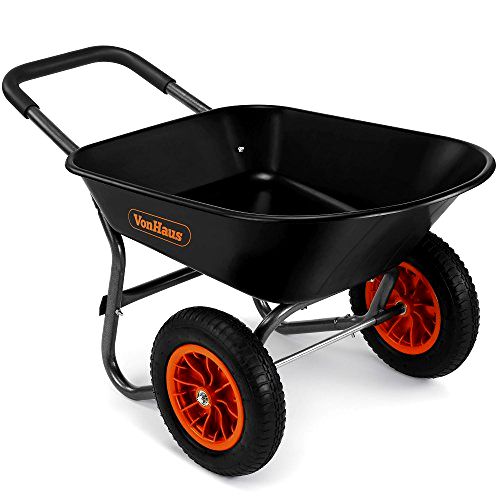
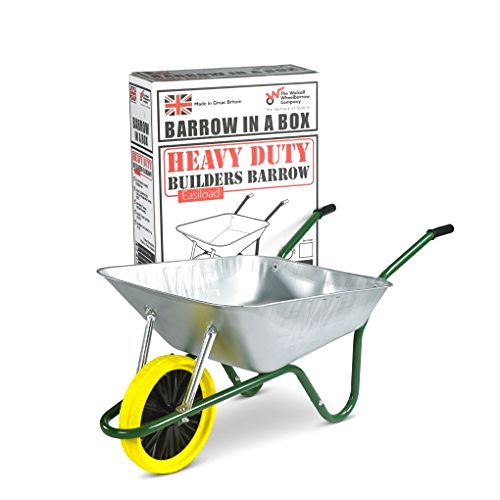
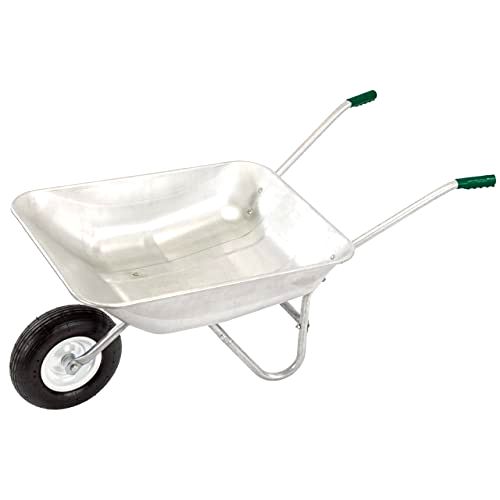
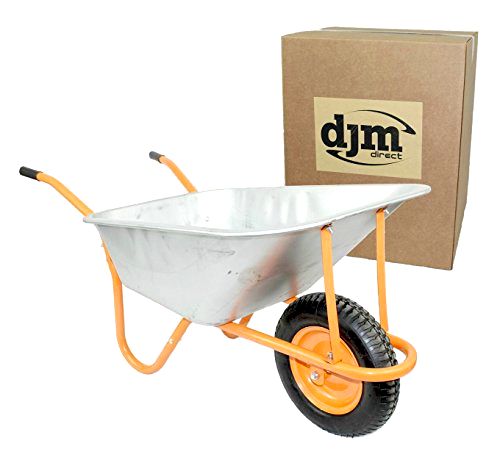
Share